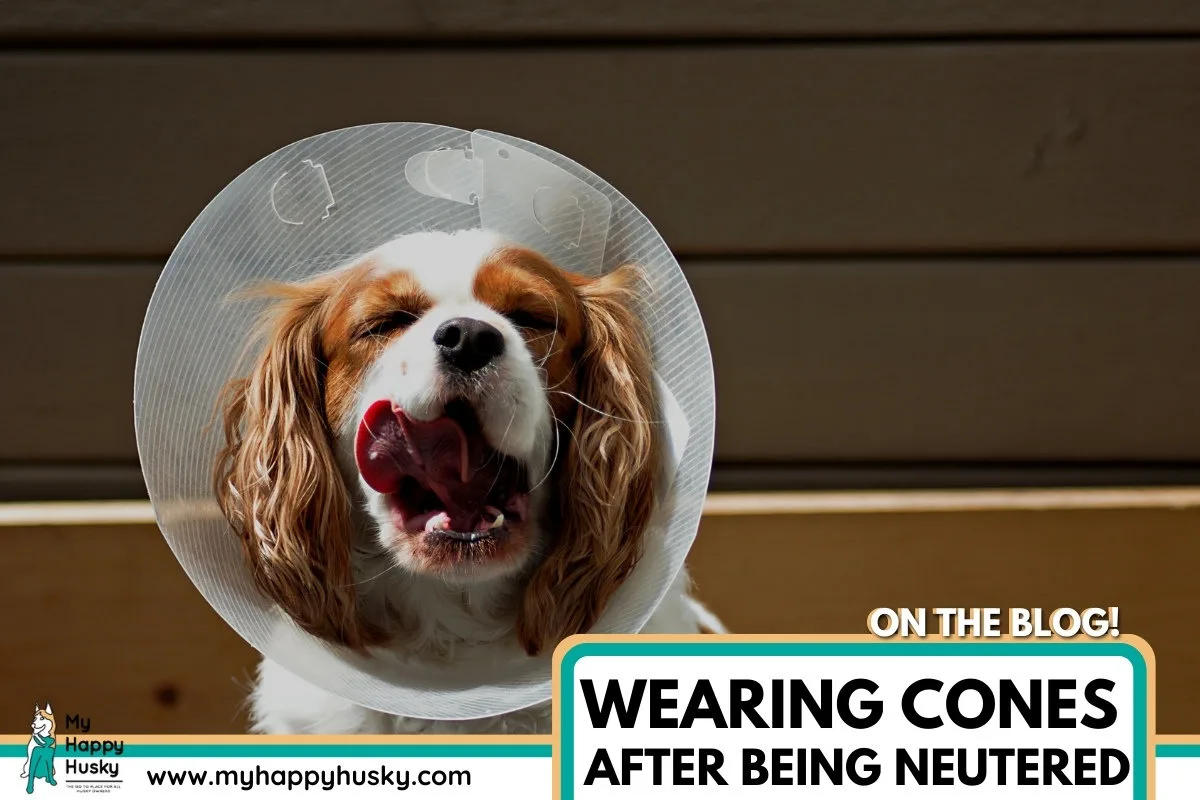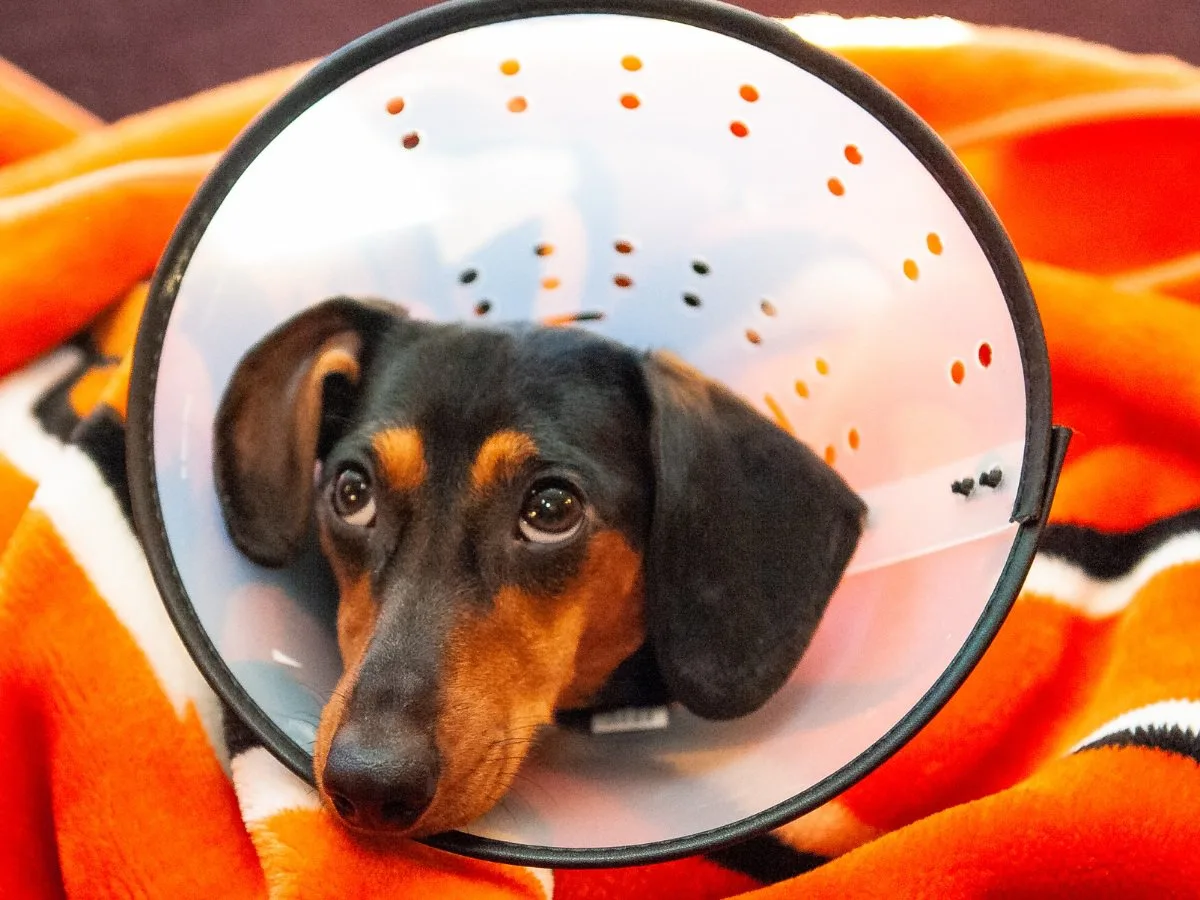If your puppy just got fixed, you’re probably asking how long they need to wear that cone.
This article gives you the straight answer and offers more tips on how to help them heal.
It’s recommended that your puppy wears his cone for 8-10 days after being neutered while his wound heals. Depending on how the wound heals and whether his stitches have come off, cone removal may be earlier or later than 8-10 days.

How Long Does The Cone Need to Be Worn?
Like we said, it’s a good idea to keep the cone on for about 10 days. Sometimes you can take it off sooner, or you might need to leave it on longer.
It all comes down to how well the wound heals and if the stitches are out. Just listen to your vet and everything should be okay.
The point of a cone:
The whole purpose of the cone is to prevent him from licking, scratching, and biting his wound in order for it to heal properly. The stitching could be ripped and the wound may reopen if your pup consistently aggravates it.
Some puppies take no notice of the healing wound and may not even need a cone, but for the majority of pups, a cone will be necessary.
Do You Remove The Cone For Eating or Sleeping?
The truth is that dogs and pups can sleep, eat, drink, poop, and pee all while wearing their cone. So technically, it doesn’t need to be removed at all.
If your pup finds it hard to eat with the cone, you can take it off just during mealtime. But be sure to watch him closely so he doesn’t try to mess with his wound. Some puppies can be pretty sneaky when they want to be.
Important! It only takes a few seconds of biting to ruin all the stitching that took so long to put in place. It’s not worth the risk.
The stricter you are with the cone, the quicker your pup will get used to it, so try your best not to remove it unless absolutely necessary.

Instead of Removing The Cone, Trim It Down
If your pup is really struggling with the cone, it could be that it’s actually too big for his size.
Instead of removing the cone altogether, start by trimming it down an inch all around and see how this improves his maneuverability.
Be cautious! If you cut the cone too short, it won’t do its job. Your pup shouldn’t be able to reach the wound. So, just trim a small bit off to start with.
Plastic cones can usually be cut with a good pair of scissors.
Making Him Feel Comfortable With The Cone
In the first few days of wearing the cone, he will be very confused and uncomfortable. Not to mention he’s just undergone surgery as well, and now he’s got a huge traffic cone around his head!
It can be overwhelming, to say the least, so it’s crucial for us to help.
● Be There For Him
Puppies and even adult dogs don’t like being left alone at the best of times, let alone when they are physically impaired and recovering.
Remember that your puppy’s vision will be significantly reduced, and bumping into things will happen often. This can be both frightening and frustrating for a young puppy.
Being around him will help him feel comfortable and relaxed and you’ll be there to assist him to move around and go about his day.
● Be Ready to Carry Him
If you’re able to, carry him when he needs to walk far or if he’s really struggling. He’ll also enjoy the attention too!
Whether you’re taking him out with you to run errands, visiting the vets again, or even just going upstairs, you may have to pick him up and carry him.
Don’t let your puppy struggle unnecessarily. After all, the cone is only temporary and you can’t expect him to adapt so quickly.
● Use Treats to Keep His Head High (walking training)
Dogs and puppies learn to walk with their head down, sniffing the floor as they go. When your pup wears a giant cone, walking will be difficult and the cone will frequently dig into the ground.
If you notice your pup is struggling to walk, you can try training him to walk with his head up.
Take a tasty treat (plain boiled chicken breast is good) and keep it in your palm and close your first, allowing there to be a small hole for him to smell.
In a large space with no bumping hazards, hold your fist to his nose held high and start walking backward, allowing him to follow your fist, occasionally giving him a tidbit of chicken, do this a few times each day for the first few days and he’ll learn to walk holding his head up.
● Sometimes Taking The Cone Off is The Right Thing to Do
But only momentarily! Although I mentioned how important it is to keep the cone on as much as possible, there are times when you can remove it, especially if he’s struggling to eat.
If you do choose to remove his cone in order for him to eat or drink, then you MUST be closely supervising him to ensure he doesn’t bite his wound.
Some owners recommend taking their cone off for 30 minutes every evening time once their puppy has calmed down, just for them to have a “break” from their cone, you can lay them on the sofa with you and let them rest without it. This is absolutely fine, as long you’re there to supervise.
More Comfortable Alternatives to Cones
Fortunately, there is a range of cones available that are softer, different shapes, designs and some are far more comfortable than others.
The reason most people resort to the typical wide plastic cone is that naturally, we forget that our pup is even going to need one. But ordering one online in advance is a great thing to do.
Most puppies will prefer a cone “donut” and these are not only more comfortable than regular cones, but they don’t impair your pup’s vision. You just need to take some measurements and ensure he won’t be able to reach his wound. I really recommend taking a look at these. They have great reviews and are reasonably priced.
Helping Your Puppy Heal Quickly After Surgery
It helps to remember that any kind of surgery is going to take quite a toll on your pup. He’s going to be nauseous from the medication, he’s going to be sore, and also very tired while his body does it’s best to recover.
Fortunately, there are some ways that you can help your pup recovery quickly and efficiently.
● Your puppy will feel very nauseous for 24 hours after the surgery while the anesthesia wears off, so refrain from feeding him. After this, he’ll need to eat again, and you can start him on some bland food like white rice, potato, and plain boiled chicken breast for the next few days, before returning to his kibble.
● Hydration is everything. Encourage him to drink frequently and you can even add a tiny amount of chicken broth to his water just for extra encouragement. Staying hydrated will be key in helping his body recover.
● Don’t let your puppy get wet the week before his surgery. No bathing, swimming, or going out in the rain. Getting wet increases the chance of infection so it’s recommended to avoid it all together well before his surgery is due.
● Let him rest and don’t encourage him to play or exercise. His wound will need all the help it can get and any exaggerated or fast movement could irritate it and in the worst cases, even loosen the stitches. Keep him inactive for the first week after surgery
● Make his environment calm and peaceful. He will be very tired and generally feeling sluggish while he recovers. Keep the kids or other pets from disturbing him and ensure that he’s as comfortable as possible. He needs a lot of TLC after his surgery!
● Invest in a more comfortable cone! Try out one of the “donut” cones as I recommended above. This will make his life easier right away.
Last Thoughts
So there you have it! You now know that your puppy needs to keep his cone on for around 10 days or whenever the wound has healed and the stitches are completely off. The cone is there to stop him from reopening or disturbing his wound.
Recommended Products
My Happy Husky frequently recommends top products, here are some of our best picks below:
● Best dog crate
● Best cooling bed
● Best interactive dog toy
● Best calming puppy toy
● Best pet insurance
Disclaimer
The advice given in this article is for educational purposes only and does not constitute professional advice in any context. Before making any decisions that may affect the health and/or safety of your dog, you should always consult a trained veterinarian in your local area. For the FULL disclaimer Visit HereCopyright Notice: The content produced and published on My Happy Husky is unique and original. My Happy Husky makes an active effort to search for plagiarized content using plagiarism detection software. If plagiarized content is found, action will be taken.
